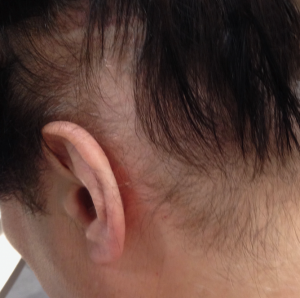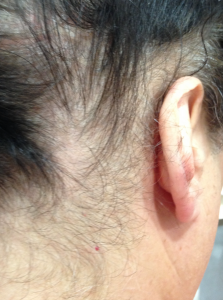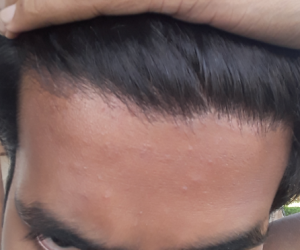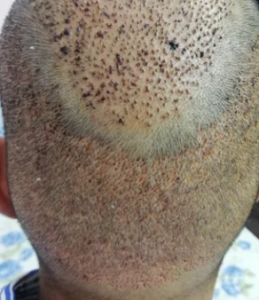This is a great video which shows many photos of what to look for in patients, the doctors work and how they do it, the importance of the microscope in every FUE, etc.. The speaker had the worst hair transplant from the 1990s on his own head and had it fixed, but probably put the hairline a tad bit too high. He missed two important nuances of the FUE. (1) The skin of the FUE grafts is trimmed under the microscope. By trimming off most of the skin, the cobbling of the skin, something called cobblestonning (like the old streets which used bricks instead of pavement) produces small elevations of the graft at the point where the skin enters the scalp. (2) The grafts are always placed flush with the skin so that bumps never appear at the point where the grafts enter the scalp. Nevertheless, this is one of the best videos I have seen for evaluating a doctor.
I feel I must comment on your experiment. Yes, doctors do inject fat into the scalp, and yes, doctors do inject platelet rich plasm (PRP) into the scalp. But no, there is absolutely no evidence that either of these work to grow hair and applying it to your scalp will not get it inside of the scalp because the epidermis (a 1/2 mm thick and tough layer of the skin) protects the scalp largely from outside influences. So, although I wish you luck on your experiment, which I hope to see results here on Reddit in the future, I am not optimistic about it.
Lard Experiment – I will massage Lard into my scalp once per week for 6 months to see if I can grow hair in temples from tressless
This is an important article because it explains why I probably have never seen a case of post-finasteride syndrome in the thousands of patients who were prescribed the drug by me over the past 2 decades. When someone complains of ED, I either reduce the dose until the symptoms go away, or discontinue the drug. According to this article, it takes years on the drug to get PFS. Since I am responsive to recommending withdrawal of the drug, the incidence in my practice is non-existent. The article itself has limitations in its methodology and as a definitive statement about the existence of post-finasteride syndrome or a disclosure of the risks, so it must be taken with a grain of salt.
https://www.ncbi.nlm.nih.gov/m/pubmed/28289563/
I am 38 years old and in the early stages of male pattern baldness. Currently, I am probably type 2 but it could evolve into type 4. I have been using coconut oil for the past 1-2 months and I do notice some growth (maybe 5%). However, I was looking into getting a minor hair transplant (FUE). I just had a few questions. If you could shed some light, I would be grateful. Thanks!
-
I have a short haircut in general with buzzed sides and long hair on top. Do I have to shave my head completely for the procedure?
-
If I get a minor transplant, and somehow it gets worse in the future, would I be able to get another one? Why do some people say you can only get a few transplants throughout your lifetime? Assuming you have enough donor hair.
-
Do I have to be on medications after getting a transplant? I am looking into this because I did not want to be on propecia or monoxidil due to the side affects.
-
How often do you have to come back for checkup and what does the entire procedure entail?
-
Is there usually a minimum number of grafts that a doctor requires?
1. You only need to shave the back of your head short and within a week it will look like normal short hair.
2. There are lifetime limits to FUE and hair transplants in general. If you exceed these limits, then you can become bald in the back of your head. Read here: https://newhair.com/donor-area/
3. I would like to see pictures of your hairline. If you were my patient, I would do a HAIRCHECK test to find out what the naked eye can’t see from planning purposes. Send photos to: wrassman@newhair.com
4. Once a hair transplant is done, other than a final sign-off with the doctor when it is grown out, there is no real maintenance.
5. There is an activation cost for the surgery room, the staff, and the set-up which is embedded into our fees. Generally, there is a $3,500-4,000 minimum cost but that would include about 600 grafts if it is not FUE.
I look forward to hearing more from you after reviewing photos.
It is very difficult to tell from this photo if you are receding or developing a maturing hairline. The best way to determine this is to lift your eyebrows so that your forehead wrinkles and the hairline should be no higher than one finger breath above the highest wrinkle. If this is the case, maybe your hairline is maturing.
This is a 60 year old male who is a patient of mine who I had not seen for 5 years. Over the past 5 years, his neck hair has significantly reduced as shown in the attached photo. I have told most of my patients to never harvest neck hair for two reasons: (1) it does not last their lifetime compared to regular scalp hair and (2) it leaves terrible scars. Too many doctors rush to get more grafts so that they can charge more money in performing a hair transplant so they will harvest the neck hair and have these two problems as a person ages.


I have about 90 cm2 of baldness and about 200 cm2 of possible donor area. When I counted 1 cm2 of donor 3 times, I got 110,113 hairs and 123 follicular units per 1 cm2. I was wondering if the ones with red arrow are still the same follicular unit even though the hairs are spaced out compared to one with green arrow.
You are pointing out the follicular units that have more than one hair. Sometimes they exit the same pore and sometimes it appears to exit next to the main pore. The count of 110,113 hairs is about the average hair count in a Caucasian male and the number of follicular units are about 50,000 or 2.2 hairs per follicular unit on average. Clearly, some of the Follicular units have higher hair counts and others may just have a single hair. If you look at the leading edge of a normal hairline, you will see all single hair follicular units transitioning into more hairs per follicular unit as you move away from the leading edge. You were very astute in your analysis. The next step is to calculate the size of the balding area you are thinking about transplanting. That is just the beginning of the next analysis where multivariate analysis comes into play. The other variables that must be considered are (a) hair thickness, (b) character of your hair (wavy or straight), (c) the thickness of the hair shafts (fine, medium or coarse) and last and most important is where you are heading with your existing balding (based upon HAIRCHECK analysis, family history, your age, if you are going to treat the progressive nature of balding, and your long term medical plan with regard to going forward management).
I have been noticing my hair has been thinner around my crown for about 8 months. When I tell my parents they say they don’t notice until I point it out and no one else has pointed it out. However, when I take pictures, I can clearly see the area where my hair is thinner than the rest. My hairline is not receding, but I was wondering if there is anything I can do to reverse the thinning before it’s to late. I have been using nizoral for about a month now.
The crown is often the place where genetic balding starts and it starts with thinning. You might want to see a doctor, get a diagnosis, and build a Master Plan for what your future hair loss will be. A HAIRCHECK test is a good idea as well to get a baseline to compare hairloss. Nizoral will not help you.
So I went to the dermatologist after my barber noticed a bald spot on my crown. He didn’t seem to really care (as he was bald) but he wrote me a prescription for finasteride and minoxidil. However, my wife and I are about to have our first child and we want to have another one. She’s taking a strong stance on me not starting finasteride until we have our second kid. She’s worried about fertility. Is it worth starting on minoxidil then getting on finasteride in a couple years? I’m worried I won’t stick to minoxidil twice a day since I work shifts so it makes it really tough to apply.
You can use minoxidil once a day at night after a hot shower and leave it on until morning. That works and it is less of a headache.
One never gets enough information. Estrogen protects the hair follicle from the genetic devastation in women that normally affects men with the same genetic code.
https://academic.oup.com/edrv/article/27/6/677/2355194
Leg hair is not a great idea as only 50% is in the growth phase at any time, so it doubles the cost. Also, leg hair does not grow long and typically falls out in 5-6 months. It then goes to sleep phase and wakes up to grow for another 5-6 months before falling out again.
I had a patient who I brought to the International hair meetings where there were about 400 doctors present. He had alopecia totalis, not a single hair on his body anywhere. He had SMP done by us, and when the doctors met him, none of them could tell he had SMP even though they knew. A well done SMP should be undetectable. The hair can be shaved or long, nothing in-between works as well.

People with SMP, can you tell its SMP from really close? from tressless
A lot of girls need to touch men’s hair during sex, grabbing them all the time, running their fingers through them etc. Do you have any experience/stories/tips regarding this issue? So, even if you fix toppik powder with some hairspray, you can sometimes scratch it off your scalp or hair, can’t you? I’m around NW 2.5 and I’m currently wearing a type of mohawk hairstyle that is almost permanently waxed. So, it’s pretty obvious just from looking at it she shouldn’t touch it, but you’ll never know. And what about showering together, any stories/possible solutions?
Scalp Micropigmentation solves this problem as it is a permanent concealer (See: https://scalpmicropigmentation.com/bold-shaved-look/).
No, your donor area is depleted. I don’t believe that 99% of people who get 5000 FUE grafts can support that number without getting a see-through donor area. Your residual donor density is probably too low for reasonable coverage. Scalp Micropigmentation works well for managing the APPEARANCE of this problem (See: https://scalpmicropigmentation.com/)





